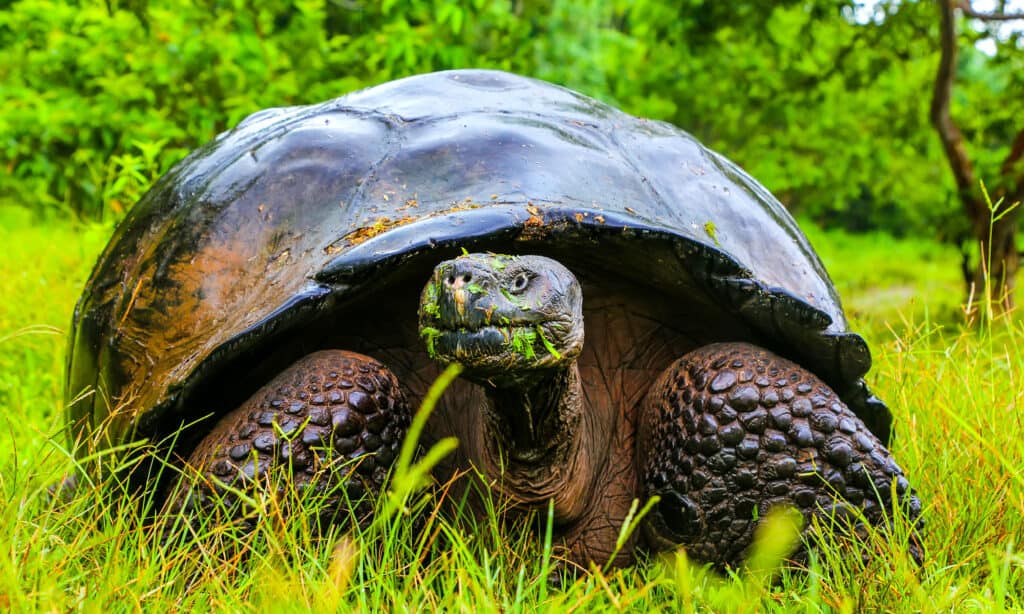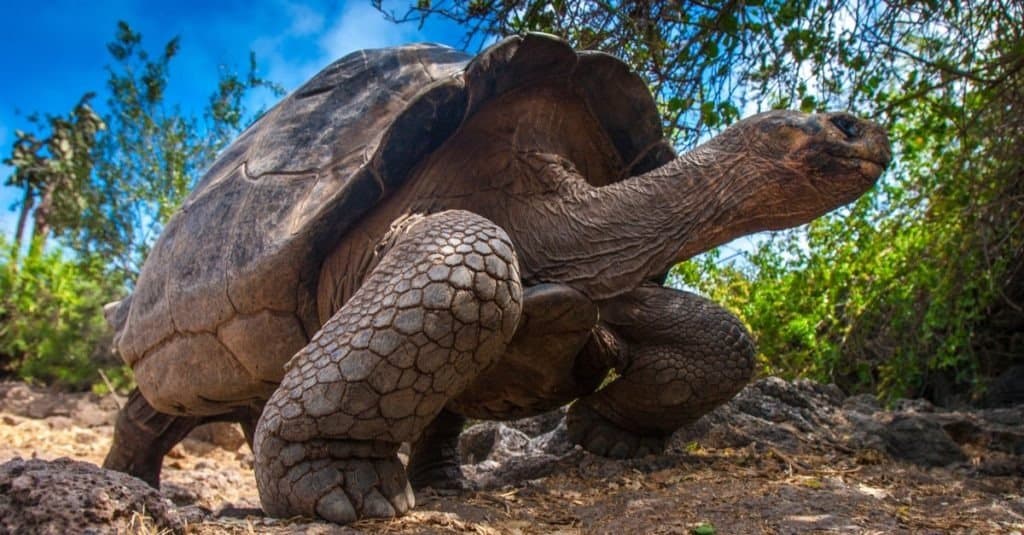Turtles are reptiles known for their longevity. Even a simple eastern box turtle can live upwards of 50 to 100 years. However, they’re not among the longest-lived species of turtles to ever live. Galápagos tortoises, a large turtle species, can live for 150 years or more. Does that make a Galápagos tortoise the oldest turtle ever?
Based on existing records, let’s look at how long this species can survive. First, let’s explore the differences between a tortoise and a turtle to dispel any confusion about the terms.
Tortoise vs. Turtle: How Are They Different?

Tortoises are well-known for their longevity, with some estimated to live 100 to 150 years.
©iStock.com/Donyanedomam
All tortoises are turtles, but not all turtles are tortoises. The term “turtle” often refers to any creature belonging to the phylogenetic order of Testudines. They all have shells that offer protection, but some can retract their heads, and others can’t.
Here are a few differences between a turtle and a tortoise:
- Tortoises only belong to the Testudinidae family within the Testudines order.
- Tortoises spend most of their lives on land, but turtles spend a fair amount of time in the water.
- Tortoises have domed, rounded shells for protection on land, while other turtles have thinner, streamlined shells for swimming.
These are just a few of the major differences between the creatures. Now, it’s time to focus more specifically on the qualities of the Galápagos tortoise.
About the Galápagos Tortoise
The Galápagos tortoise, Chelonoidis niger, is a large species of tortoise that hails from several of the Galápagos Islands. This species is known for its longevity as well as its large size. The Galápagos tortoise is also the largest extant tortoise species. Some individuals weigh upwards of 900 pounds and grow over 4 feet long. For that reason, the creature is sometimes called the Galápagos giant tortoise.
These herbivores were detailed in Charles Darwin’s writings. Oddly enough, the tortoises were used as a source of meat rather than for scientific study. The differences between those tortoises brought on board the Beagle would have helped him in his evolutionary theories if he had paid any mind to the creatures rather than eating them. Darwin did mention this was a serious oversight in his writings.
The Galápagos tortoise has a lifespan of about 100 to 150 years. That’s not altogether striking, given the lifespan of other tortoises. However, several individuals from this species have exceeded their supposed lifespan by several decades.
How Old Was the Oldest Galápagos Tortoise?

For a time, Harriet was the oldest living vertebrate with a confirmed age, making her the oldest living chelonian for many years.
©FOTOGRIN/Shutterstock.com
The oldest Galápagos tortoise to ever live was a female named Harriet, that lived for about 175 years. She was born on the Galápagos Island of Santa Cruz around 1830. Charles Darwin collected her in 1835. Based on her size at the time she was collected, scientists estimated that Harriet was about 5 years old.
Eventually, she was taken to the Brisbane Botanical Gardens, where she lived for about 100 years before reaching her final home, Australia Zoo. Sadly, Harriet passed away on June 23, 2006. For a time, Harriet was the oldest living vertebrate with a confirmed age, making her the oldest living chelonian for many years.
Lonesome George was another long-lived Galápagos tortoise with a sadder story. This tortoise belonged to a subspecies of Galápagos tortoise called the Pinta Island tortoise, Chelonoidis niger abingdonii. Lonesome George hatched from his shell in about 1910, and he passed away at the age of 101 or 102. Despite the aid of conservationists that wanted to help the large turtle breed and continue its subspecies, Lonesome George died without any known offspring.
Unlike Harriet, Lonesome George spent most of his life in the wild. Thus, it’s harder to know how old he really was when he died. Researchers are trying to find ways to resurrect the subspecies using DNA from relatives of extinct species.
How Long Do Turtles Live on Average?
Turtles are exceptionally long-lived reptiles. A species as common as a red-eared slider can live for 25 to 35 years. An eastern box turtle is expected to live about 50 years or more. Some sources claim that they can live for about 100 years at their maximum.
Small tortoises can live for a long time. For example, Tu’i Malila, a radiated tortoise from Madagascar, was supposedly about 188 or 189 years old. Some sources claim that the tortoise was a gift from Captain James Cook in 1777, but others said that the King of Tonga received the turtle in the mid-1800s. Tu’i Malila died in 1966, making it at least 100 years old.
Large tortoises are by far the most long-lived species of turtles. We’ve already mentioned several cases where Galápagos tortoises have exceeded 100 years, with one getting close to 200 years old. Let’s see how these turtles compared to some of the oldest turtles.
Was the Oldest Turtle Ever a Galápagos Tortoise?
No, the oldest turtle ever was not a Galápagos tortoise. The oldest turtle is 190 or 191 years old, and its name is Jonathan. This turtle is a Seychelles giant tortoise with the scientific name Aldabrachelys gigantea hololissa. The Seychelles giant tortoise is a subspecies of the Aldabra giant tortoise.
Jonathan surpassed Harriet the Galápagos tortoise and Tu’i Malila to become the oldest turtle ever. Jonathan was collected in 1882. He was fully mature then, meaning he was at least 50 years old. So, if he hatched in 1832, that would make him 191 or 192 as of this publication.
However, some other claims about even older turtles exist. Two other Aldabra giant tortoises were supposedly 255 and 344 years old, but both claims are highly contested and unlikely.
In any case, the oldest turtle was not a Galápagos tortoise, but another giant tortoise species.
Up Next:
- The Oldest Hamsters to Ever Live
- The Oldest Mammals Ever Found
- The Oldest Men to Ever Live
- Discover The Oldest Chimpanzee Ever Recorded
The photo featured at the top of this post is © Fotos593/Shutterstock.com
Thank you for reading! Have some feedback for us? Contact the AZ Animals editorial team.






